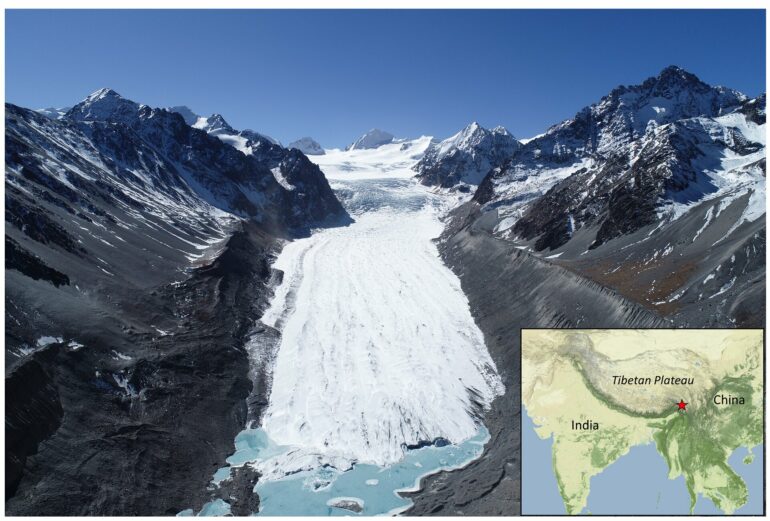by Beate Kittl, Eidgenössische Forschungsanstalt für Wald, Schnee und Landschaft WSL
Millions of people depend on water from the glaciers of High-Mountain Asia. South-eastern Tibet, however, has some of the most rapidly melting glaciers in Asia. This is due to less summer snowfall, as a study led by the Swiss Federal Institute for Forest, Snow and Landscape Research WSL shows.
Unlike in the Alps, glaciers on the Tibetan Plateau receive most of their snowfall during the summer months, which are the wettest but also the warmest. The glaciers in the south-eastern Tibetan Plateau feed the Brahmaputra River, on which millions of people downstream rely for domestic, agricultural, and industrial uses.
Earth-observation satellites have recently revealed that glaciers in this region are experiencing some of the highest mass loss rates within Asia, and this loss is accelerating in the last decades. We know that rising temperatures due to climate change are causing glaciers to melt, but is this really the only factor behind the rapid retreat of the glaciers in this region?
No, as research led by Achille Jouberton and Francesca Pellicciotti from WSL, in collaboration with the Institute of Tibetan Plateau Research at the Chinese Academy of Sciences shows. The scientists have disentangled the mechanisms behind south-eastern Tibet glaciers’ high sensitivity to warming.
45 years of change modeled
To identify these mechanisms, they used a state-of-the art model to reconstruct the climate and mass changes of Parlung No.4 glacier in south-eastern Tibet over the last 45 years. That is the longest period of time for which changes in a glacier in this region have ever been reconstructed. The so called glacio-hydrological model the scientists used was informed by an extensive set of data collected on site and by remote sensing. Glacio-hydrological models integrate both glaciological and hydrological processes, e.g. glacier and stream flow.
Long-term changes in the precipitation phase are very difficult to observe, especially at the high elevations of glacier accumulation areas. They require continuous precipitation measurements that are often costly and subject to large uncertainties. Therefore, using a well-informed model that was calibrated with locally collected data was the most practical way to quantify them.
Rain instead of snow in summer
The researchers found that most of the mass loss acceleration was due to a shift of some of the summer precipitation from snow to rain, limiting the accumulation of snow—that eventually turns to ice—on the glaciers. Their results show that glacier melt has also increased, but that the decrease in snow accumulation was a stronger cause for recent mass loss in this region.
The fact that less snow accumulates on the glaciers has a secondary effect in exposing glacier ice to sun and warmth for a larger part of melt seasons, which can greatly enhance melt. This has also become apparent in the Alps this summer, where a small winter accumulation has led to early and excessive summer melt.
Altogether, the results show the importance of accounting for changes in glacier accumulation mechanisms in projections of glacier changes, and help to explain the particular sensitivity of summer-accumulation glaciers to warming.
The study was published in the Proceedings of the National Academy of Sciences.
More information:
Achille Jouberton et al, Warming-induced monsoon precipitation phase change intensifies glacier mass loss in the southeastern Tibetan Plateau, Proceedings of the National Academy of Sciences (2022). DOI: 10.1073/pnas.2109796119
Provided by
Eidgenössische Forschungsanstalt für Wald, Schnee und Landschaft WSL
Citation:
Why are the glaciers in southeast Tibet melting so fast? (2022, September 8)



